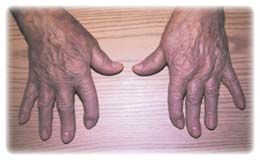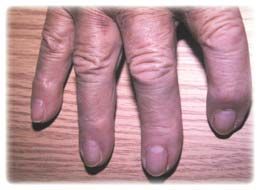An old woman's hand with deviated fingertips
A 91-year-old community-dwelling woman is seen for annual physical examination. Apart from hearing loss, she has no complaints; she continues to reside alone in an assisted-living apartment, and to take care of herself.
This article was originally presented as an independent educational activity under the direction of CME LLC. The ability to receive CME credits has expired. The article is now presented here for your reference. CME LLC is no longer responsible for the presentation of the article.

The Case
A 91-year-old community-dwelling woman is seen for annual physical examination. Apart from hearing loss, she has no complaints; she continues to reside alone in an assisted-living apartment, and to take care of herself.
More History/Physical
Woman who appears stated age. Vital signs, normal. Handwriting, unremarkable and not laborious. Can pick up spoon readily. Conversation a little difficult because of hearing impairment. (She won't turn on her hearing aid "because I don't want to run down the battery.")
What's Your Diagnosis?
• Arthritis mutilans
• Mallet finger
• Osteoarthrosis
• Phalangeal fracture
• Rheumatoid hand(Answer on next page.)

The correct diagnosis is Subluxed Terminal Phalanx in Osteoarthrosis
The hands look as old as the reported age, in part because the skin appears thin and wrinkled, so that the veins on the dorsa stand out prominently. The thumbs appear somewhat "jammed" onto the palms, especially on the left, where a bumpy first metacarpophalangeal joint replaces a normally more gradual curvature. The fingers, however, catch our attention: both fifth fingers appear stiff and out-deviated in a fashion that recalls the digiti quinti sign of mild hemiparesis.1 Both index fingers show flexion and ulnar deviation at the distal interphalangeal joint (Figure); the left middle finger displays a very similar deformity. The proximal interphalangeal joint of the right middle finger looks a bit pushed-upward into a faint shadow of the boutonniere deformity of rheumatoid arthritis (RA),2 but the overall appearance of the hands does not suggest RA. We concluded that the deformities all related to age and ordinary osteoarthrosis.
Case DiscussionMallet Finger
One entity to consider is mallet finger, analogous to mallet toe, wherein rupture of the extensor tendon leads to unopposed flexion of the terminal phalanx.3,4 However, there was no antecedent injury, nor any known disorder of tendons that should predispose to rupture. Such tendon disorders include enthesopathies and the iatrogenic links to some quinolones-chiefly implicated in Achilles tendon rupture-and to the "it weakens everything" suspicion that attaches to chronic systemic corticosteroid ingestion. Furthermore, our patient has an element of ulnar deviation that is more conspicuous, at least in these images, than the flexion deformity. Mallet finger should not produce this.
Phalangeal Fracture
It would seem highly unlikely that a single patient would have fractures of 3 separate phalanges, unless a single injury were implicated-perhaps via a landing on outstretched fingers during a fall or a motor vehicle crash. Much more familiar, and more likely in a younger woman around menopausal age, would be the braced-hand Colles fracture of the wrist.
Rotation can occur in phalangeal fractures,3 but not typically this far distally. There is no way to create a convincing single scenario that would also explain the distorted bases of the thumbs and the "outrigger" fifth fingers.4
Rheumatoid Hand
Several "What's Your Diagnosis?" columns have addressed RA in the hands.2,5-7 There is no single feature pathognomonic of rheumatoid hand; the most suggestive features include major metacarpophalangeal joint involvement and joint disease that is much more significant in the proximal interphalangeal joints than in the distal. In the present case, the abnormalities do not include a "knuckle sign." Apart from the thumbs, there is not even a forme fruste of the opera glass deformity of arthritis mutilans,7 which is most typically rheumatoid although reported in other conditions as well. Ulnar deviation of the digits is often cited as evidence for RA, but it can occur in plain osteoarthrosis as well.
Here the distal interphalangeal joints are relatively selectively involved. Such localization favors 3 differential diagnoses: the ubiquitous osteoarthrosis and the less common gouty and psoriatic arthritides.4
Not Shying Away
Distinct diagnosis of the hand can feel overpoweringly difficult to non-rheumatologist primary care physicians. Or one can venture inferences, but only about nonmusculoskeletal problems.8 However, simple assessment tools for functional disorders9 as well as for joint problems ease our task.10
The Gait, Arms, Legs, and Spine (GALS) screening test advocated by the Arthritis Foundation especially counters any intimidation factor. We do our own competence a disservice, and create a self-fulfilling prophecy, if we try to recognize only the grossest aberrations in the structure of the hand.
We constantly need to remember that function and performance can outstrip the deficits predicted from the pathologic anatomy alone, depending on motivation, cognitive state, resourcefulness, and adaptive equipment. This lesson strikes us as particularly vivid when a person with the familiar gnarled hand of end-stage RA4 manages to feed, dress, and perhaps toilet himself or herself, and to write legibly or use a computer, beyond all reasonable expectation based on the structure one observes. Conversely, problems with manual dexterity are common in osteoarthrosis, especially with distal interphalangeal and base-of-thumb joints.10
Osteoarthritis: Many Faces
Further questions remain: why does the phalanx slip (sublux) on the metacarpal head? Could an imbalance of vectors be comparable to the situation that produces cocked-up toes in diabetic neuropathy? Given that the pathology of osteoarthrosis is non-necrotizing loss of cartilage, is not the deformity more severe than one would envision or expect?
The fingertips of many aged persons resemble our patient's, despite the fact that these persons have no trauma history, attentive families, and good lifetime medical records. Published images of hands with osteoarthrosis can resemble these and sometimes look even more abnormal.4
One can invoke degeneration of one of the collateral ligaments of the distal interphalangeal joint to explain the lateral deviation in this case, although how a disorder of cartilage would lead to such a problem remains obscure, at least to me. The "classic" site of thumb involvement in osteoarthrosis is the first carpometacarpal,4,10 rather than the first metacarpophalangeal that is visibly damaged here. The second and third distal interphalangeal joints are included in classification criteria for osteoarthrosis of the hand, and in this case the "correct" digits are most affected.

Thus, only some uncommon variants of an extremely common disorder are revealed in these images. Perhaps someday they will be better understood. For now, we do not obtain biopsy material from such areas, because it would not enhance management. The hands are seldom incised at autopsy because of familial and societal concerns about disfigurement. It is therefore likely that future insights may come not from pathoanatomic study of excised tissues, but rather from extraordinary advances in imaging.
Perhaps we shall find that a certain number of these deformed "part and parcel of aging" or "part of osteoarthrosis" fingertips actually result from attenuated or interrupted tendons, and that such changes accompany rotational changes secondary to cartilage loss and osteoarthrosis-induced bone pathology as the pathophysiologic substrates. Who knows what preventive or therapeutic (including surgical) measures might result from such insights? And what new functional adaptations in both exercise and equipment might be devised by ingenious bioengineers and occupational therapists?
References:
References:1. Schneiderman H, Ritzau JM. Digiti quinti sign of mild hemiparesis: a sign of an old stroke. Consultant. 2001;41:597-602.
2. Schneiderman H. Rheumatoid arthritis with prominent swan-necklike deformity of thumb. Consultant. 1992;32(2):63-64.
3. Snider RK, ed. Essentials of Musculoskeletal Care. Rosemont, Ill: American Academy of Orthopaedic Surgeons; 1997:176-178, 215-218, 235-238, 242-243.
4. Polley HF, Hunder GG. Rheumatologic Interviewing and Physical Examination of the Joints. 2nd ed. Philadelphia: WB Saunders Company; 1978:114-135.
5. Schneiderman H. Knuckle sign and assessment of the metacarpophalangeal joints. Consultant. 1998;38:658-663.
6. Okechukwu C, Schneiderman H. Dactylitis associated with rheumatoid arthritis. Consultant. 2000;40:1867-1871.
7. Schneiderman H. Opera-glass hand, main en lorgnette, doigt en lorgnette, and resorptive arthritis. Consultant. 2005;45:1627-1634.
8. Silverman ME, Hurst JW. The hand and the heart. Am J Cardiol. 1968;22:718-728.
9. Calkins DR, Rubenstein LV, Cleary PD, et al. Failure of physicians to recognize functional disability in ambulatory patients. Ann Intern Med. 1991;114:451-454.
10. Klippel JH, Crofford LJ, Stone JH, Weyland CM, eds. The Pocket Primer on the Rheumatic Diseases. Atlanta: Arthritis Foundation; 2003:1-3, 82-84.